Plant Pathology, Department of

Department of Plant Pathology: Faculty Publications
Document Type
Article
Date of this Version
4-27-2021
Citation
Kodati S, Adesemoye AO, Yuen GY, Volesky JD, Everhart SE (2021) Origin of agricultural plant pathogens: Diversity and pathogenicity of Rhizoctonia fungi associated with native prairie grasses in the Sandhills of Nebraska. PLoS ONE 16(4): e0249335. https://doi.org/ 10.1371/journal.pone.0249335
Abstract
The Sandhills of Nebraska is a complex ecosystem, covering 50,000 km2 in central and western Nebraska and predominantly of virgin grassland. Grasslands are the most widespread vegetation in the U.S. and once dominated regions are currently cultivated croplands, so it stands to reason that some of the current plant pathogens of cultivated crops originated from grasslands, particularly soilborne plant pathogens. The anamorphic genus Rhizoctonia includes genetically diverse organisms that are known to be necrotrophic fungal pathogens, saprophytes, mycorrhiza of orchids, and biocontrol agents. This study aimed to evaluate the diversity of Rhizoctonia spp. on four native grasses in the Sandhills of Nebraska and determine pathogenicity to native grasses and soybean. In 2016 and 2017, a total of 84 samples were collected from 11 sites in the Sandhills, located in eight counties of Nebraska. The samples included soil and symptomatic roots from the four dominant native grasses: sand bluestem, little bluestem, prairie sandreed, and needle-and-thread. Obtained were 17 Rhizoctonia-like isolates identified, including five isolates of binucleate Rhizoctonia AG-F; two isolates each from binucleate Rhizoctonia AG-B, AG-C, and AG-K, Rhizoctonia solani AGs: AG-3, and AG-4; one isolate of binucleate Rhizoctonia AG-L, and one isolate of R. zeae. Disease severity was assessed for representative isolates of each AG in a greenhouse assay using sand bluestem, needle-and-thread, and soybean; prairie sandreed and little bluestem were unable to germinate under artificial conditions. On native grasses, all but two isolates were either mildly aggressive (causing 5–21% disease severity) or aggressive (21–35% disease severity). Among those, three isolates were cross-pathogenic on soybean, with R. solani AG-4 shown to be highly aggressive (86% disease severity). Thus, it is presumed that Rhizoctonia spp. are native to the sandhills grasslands and an emerging pathogen of crops cultivated may have survived in the soil and originate from grasslands.


Comments
Open access